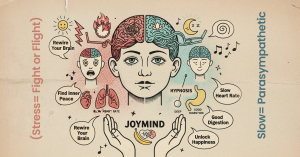Introduction: Beyond “OK”—The Real Definition of Wellness
Too often, wellness is understood as the absence of disease, stress, or pain. But true wellbeing transcends mere survival. It’s not about being “okay”—it’s about operating from a higher frequency: cognitive clarity, emotional mastery, spiritual alignment, and physical vitality. In short, wellness is peak performance.
Whether you’re an executive optimizing decision-making, a creative pushing into flow states, or a human simply wanting to live well, the integration of neuroscience, hypnotherapy, and health coaching offers a blueprint to rewire your inner landscape for success.
This article introduces a six-part daily framework—rooted in cutting-edge brain research and proven clinical hypnotherapy methods—designed to elevate your wellbeing and turn self-talk into a precision tool for neuroplastic change.
The Neuroscience of Speech and Wellness
Spoken language does more than express emotion—it changes the brain. Recent studies reveal that intentional verbalization triggers shifts in the prefrontal cortex, calms the amygdala, and enhances dopamine regulation, all of which contribute to a state of regulated, empowered wellness (Falk et al., 2015; Fox et al., 2015).
When we combine these insights with hypnotherapy, which accesses the subconscious directly, we exponentially increase our ability to create emotional balance, sharpen cognition, and fuel personal transformation.
This is the future of health coaching—a multidisciplinary approach that leverages behavioral science, therapeutic hypnosis, and positive psychology to generate breakthroughs in wellbeing.
6 Hypnotic Statements That Elevate Your Wellness
1. “I Choose Growth”
This affirmation does more than shift your mindset—it upgrades your wellness orientation. Saying it out loud engages the dorsolateral prefrontal cortex, the brain’s command center for future planning and goal execution (Cascio et al., 2016).
In hypnotherapy, this phrase acts as a post-hypnotic anchor—a neural nudge to move through resistance with grace. From a health coaching perspective, this is your commitment to lifelong evolution.
✅ Wellness shift: You stop managing symptoms and begin embodying expansion.
2. “I Act with Integrity, Even When No One is Watching”
Authenticity and alignment are pillars of high-level wellbeing. Neuroscience shows that identity-based affirmations activate brain areas linked to self-regulation and ethical reasoning (Falk et al., 2015). Integrity, spoken aloud, becomes not just a moral choice—but a wellness strategy.
This is where health coaching overlaps with values-based living. When your actions match your internal compass, your nervous system calms, your cognitive load lightens, and your confidence grows.
✅ Wellness shift: Less inner conflict, more coherent identity.
3. “I Am Grateful for Three Specific Things, Right Now”
Gratitude isn’t fluff—it’s neurochemistry. Research shows gratitude practices increase dopamine and serotonin, reduce inflammatory markers, and stimulate the ventromedial prefrontal cortex, fostering long-term emotional regulation (Zahn et al., 2009; Fox et al., 2015).
In hypnotherapy, gratitude is a trance-induction tool that softens the inner critic and opens the door to joy. In health coaching, it reframes the day’s narrative from lack to abundance.
✅ Wellness shift: Your attention system rewires toward joy, reducing anxiety and rumination.
4. “When I Feel ________, I Will ________”
This is the classic “if-then” mental model, backed by decades of cognitive science as a way to close the intention-behavior gap (Gollwitzer, 1999). It primes the brain for action by pairing emotional cues with planned responses—creating neural shortcuts for resilience.
This simple structure empowers emotional self-regulation, a key goal in health coaching. In hypnotherapy, it becomes a powerful suggestibility tool to increase automatic follow-through.
✅ Wellness shift: You become proactive, not reactive—your behavior aligns with your aspirations.
5. “I’m Allowed to Learn as I Go”
Self-compassion activates the insula and anterior cingulate cortex, the brain regions that govern empathy and emotional processing (Longe et al., 2010). This phrase disrupts the inner critic and replaces shame with growth orientation.
In both health coaching and hypnotherapy, we find that allowing space for trial and error improves neuroplasticity, emotional safety, and innovation. You give yourself permission to be in process.
✅ Wellness shift: You move from perfectionism to progress—and your nervous system breathes.
6. “I Am Becoming Who I Was Meant to Be”
This is the apex affirmation—the one that links current action to a future identity. It’s the essence of visionary wellness and what we train for in peak performance hypnotherapy. Future-oriented affirmations light up brain circuits tied to agency, hope, and reward processing (Klein & Harris, 2009).
In health coaching, we call this future self-mapping. In hypnosis, we call it time distortion re-patterning—rehearsing the self you’re becoming until it feels inevitable.
✅ Wellness shift: You stop reacting to life and start designing it.
The Framework: Wellness as Frequency
Let’s be clear: wellness is not a static state. It is a frequency—a vibrational coherence between body, mind, and spirit. True wellbeing occurs when your physiology, thoughts, emotions, and actions resonate in harmony toward growth.
The six statements above are frequency attuners. They are the tuning forks of your neurological instrument, aligning you with vitality, joy, and purpose.
At Joymind, we call this “subconscious optimization.” In our work with clients through hypnotherapy and wellness-oriented health coaching, we witness how consistent internal messaging changes outcomes—financially, emotionally, spiritually, and physically.
🎯 Wellbeing is not the absence of illness—it’s the presence of power.
Closing Thought: Wellness Starts with a Whisper
One sentence, spoken daily, becomes a neural groove. Six sentences become a framework for flourishing. This is the new frontier of health coaching—Joymind delivers virtual hypnosis—where neuroscience, hypnotherapy, and conscious language converge.
If you’ve been waiting for a sign to elevate your wellbeing…
“When was the best time to plant a tree?”
Twenty years ago.
“When is the second best time?”
Now. 🌳
📚 References
Cascio, C. N., O’Donnell, M. B., Tinney, F. J., Lieberman, M. D., Taylor, S. E., Strecher, V. J., & Falk, E. B. (2016). Self-affirmation activates brain systems associated with self-related processing and reward and is reinforced by future orientation. Social Cognitive and Affective Neuroscience, 11(4), 621–629. https://doi.org/10.1093/scan/nsv136
Elkins, G., Barabasz, A., Council, J., & Spiegel, D. (2015). Advancing research and practice: The revised APA Division 30 definition of hypnosis. American Journal of Clinical Hypnosis, 57(4), 378–385. https://doi.org/10.1080/00029157.2015.1011472
Fox, G. R., Kaplan, J., Damasio, H., & Damasio, A. (2015). Gratitude facilitates healthy decision-making and benefits mental health. Frontiers in Psychology, 6, 1491. https://doi.org/10.3389/fpsyg.2015.01491
Falk, E. B., Berkman, E. T., Mann, T., Harrison, B., & Lieberman, M. D. (2015). Predicting persuasion-induced behavior change from the brain. Journal of Neuroscience, 30(25), 8421–8424. https://doi.org/10.1523/JNEUROSCI.0063-10.2010
Gollwitzer, P. M. (1999). Implementation intentions: Strong effects of simple plans. American Psychologist, 54(7), 493–503. https://doi.org/10.1037/0003-066X.54.7.493
Klein, W. M., & Harris, P. R. (2009). Self-affirmation enhances attentional bias toward threatening components of a persuasive message. Psychological Science, 20(12), 1463–1467. https://doi.org/10.1111/j.1467-9280.2009.02467.x
Longe, O., Maratos, F. A., Gilbert, P., Evans, G., Volker, F., Rockliff, H., & Rippon, G. (2010). Having a word with yourself: Neural correlates of self-criticism and self-reassurance. NeuroImage, 49(2), 1849–1856. https://doi.org/10.1016/j.neuroimage.2009.09.019
Zahn, R., Garrido, G., Moll, J., & Grafman, J. (2009). Individual differences in posterior cortical volume correlate with proneness to pride and gratitude. Social Cognitive and Affective Neuroscience, 4(3), 238–244. https://doi.org/10.1093/scan/nsp009
















